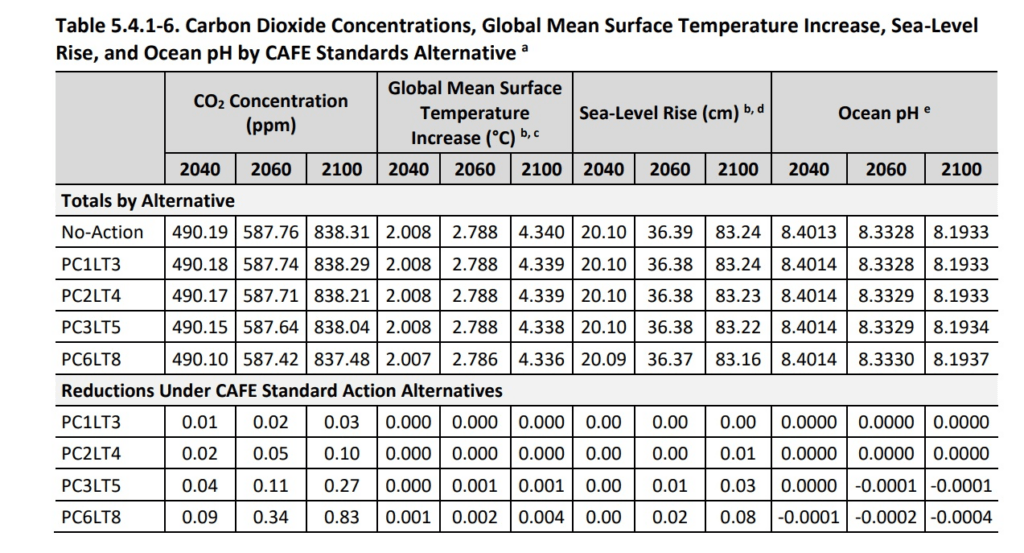Cease and desist, CEI urges National Highway Traffic Safety Administration

Photo Credit: Getty
I submitted comments on behalf of CEI to the National Highway Traffic Safety Administration (NHTSA) Monday on its proposed model year (MY) 2027-2032 corporate average fuel economy (CAFE) standards. CEI’s comments develop the case that NHTSA’s proposal is unlawful under the major-questions doctrine, as articulated by the Supreme Court in West Virginia v. EPA (2022), and on statutory grounds.
The comments expose a profound twofold inconsistency between NHTSA’s proposed CAFE standards and the Environmental Protection Agency’s (EPA) proposed greenhouse gas (GHG) standards. That is a sharp break from the agencies’ practice during the Obama and Trump administrations, when they proposed and finalized CAFE and GHG standards in joint rulemakings.
In the Obama and Trump administrations, equivalent stringency was considered the only rational approach because carbon dioxide (CO2) constitutes 94 percent of a vehicle’s tailpipe GHG emissions, and a vehicle’s CO2 emissions per mile are directly (mathematically) proportional to its CO2 emissions per mile. In other words, CAFE standards implicitly regulate motor vehicle GHG emissions, and GHG standards implicitly regulate fuel economy. Fuel economy and tailpipe CO2 emissions are “two sides of the same coin.”
In the Obama administration’s joint 2010 and 2012 rulemakings (which together cover MYs 2012-2025), the agencies repeatedly boasted that their respective CAFE and GHG standards were “harmonized,” “coordinated,” and “consistent.” After all, it is neither efficient nor reasonable to subject automakers to conflicting fuel economy requirements.
Unless, that is, you are the Biden administration, and your objective is to force internal combustion engine (ICE) vehicles out of the automobile market. That policy is unlawful under the major-questions doctrine because Congress never authorized the EPA to implement such a fundamental policy shift of vast economic and political significance. It is unlawful on statutory grounds because section 32902(h) of the Energy Policy and Conservation Act (EPCA) implicitly prohibits NHTSA from using CAFE standards to restrict ICE vehicle production and sales.
In the agencies’ current proposals, the EPA’s GHG standards are far more stringent than NHTSA’s CAFE standards on a fleetwide basis, whereas NHTSA’s are significantly more stringent for the ICE vehicle segments of manufacturers’ fleets.
Although inconsistent, the agencies’ standards are coordinated as a squeeze play or one-two punch within a vehicle electrification strategy. In a nutshell, the EPA’s GHG standards are so stringent that manufacturers cannot comply without continually shifting production and sales from ICE vehicles to EVs. However, NHTSA’s standards for ICE vehicles ensure that manufacturers have two compliance headaches instead of one—unless they withdraw from the ICE vehicle market altogether.
Thus, NHTSA’s standards increase the pressure on manufacturers to electrify their fleets or do so more quickly than planned. In automotive lingo, NHTSA’s standards give the EPA’s standards a power boost.
That’s not all. NHTSA’s standards provide a vehicle electrification backstop if courts vacate the EPA’s GHG standards and California’s zero-emission vehicles (ZEV) program.
As noted, on a fleetwide basis, NHTSA’s standards are not as stringent as the EPA’s. However, NHTSA’s standards are stringent enough to force significant EV sales if the EPA’s and California’s more aggressive policies crash and burn.
NHTSA’s CAFE standard for MY 2032 passenger cars is 66.4 mpg. According to FuelEconomy.Gov, a joint Website of the EPA and Department of Energy, Toyota’s most fuel-efficient MY 2023 Prius hybrid gets 57 mpg.

Toyota also manufacturers hybrids and non-hybrids with lower mpg ratings, such as the RAV-4 Hybrid Woodland Edition, rated at 37 mpg, and the Corolla Hatchback XSE, rated at 33 mpg. However, even if all Toyota vehicles were to achieve the mpg of the Prius hybrid shown above, the fleet average would still fall short of NHTSA’s standard by 16.5 percent. Absent breakthroughs in hybrid technology, a fleet average standard of 66.4 mpg would boost EV sales “if other regulatory pushes change in unexpected ways,” as NHTSA obliquely puts it.
On page 247 of NHTSA’s 263-page proposal, the agency states: “Your comments must not be more than 15 pages long.” That is not reasonable given the length of the proposal and accompanying technical documents, the economic importance of the auto industry, and the technical complexity of the issues. Indeed, such an arbitrary restriction on the public’s opportunity to comment is potentially unlawful.
My comments on other issues had to be brief. My summary of those other issues here will be even briefer.
The agencies’ greenlighting of California’s ZEV program, which is substantially “related to” fuel economy standards, conflicts with EPCA’s express preemption of such policies, compounding the unlawfulness of the agencies’ vehicle electrification strategy.
The agencies also undermine the Supreme Court’s rationales for its Massachusetts v. EPA (2007) decision authorizing the EPA to regulate tailpipe GHG emissions under the Clean Air Act. The Court claimed there is “no reason to think” the agencies could not both set CAFE-like requirements “and yet avoid inconsistency.” The Court further opined that granting the EPA overlapping authority with NHTSA would not “lead to such extreme measures” as a “ban” on motor vehicle product lines. And yet here we are! The agencies’ standards are increasingly inconsistent and aim to phase out (progressively ban) ICE vehicle sales.
EPCA section 32902(f) requires NHTSA to consider “economic practicability” among other factors when determining CAFE standards. NHTSA’s proposal ignores important aspects of economic practicability, such as the adverse health and economic impacts of an agenda that makes automobile ownership less affordable to middle- and lower-income households. For example, recent research finds a “striking and robust relationship … between [COVID-related] death rates and public transit use.” More mundanely, exclusive reliance on transit for daily transportation limits one’s options regarding doctors, dentists, and pharmacies, and one’s opportunities for employment.
The “climate crisis” rationale underpinning the administration’s vehicle electrification agenda is unscientific. The average person’s risk of dying from climate-related disasters has declined by more than 99 percent over the past century, and the relative economic impact of extreme-weather damages has declined almost fivefold since the 1980s.
As climate policy, NHTSA’s rulemaking is all pain for no gain. NHTSA’s preferred alternative (PC2LT4 below) is estimated to reduce global warming in 2100 by less than one-thousandth of a degree Celsius—an effect orders of magnitude smaller than scientists can detect or verify.

The bottom line: NHTSA’s rulemaking is unlawful and unreasonable. It should be withdrawn.